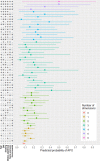Pregnancy vulnerability in urban areas: a pragmatic approach combining behavioral, medico-obstetrical, socio-economic and environmental factors
- PMID: 31827141
- PMCID: PMC6906380
- DOI: 10.1038/s41598-019-55005-0
Pregnancy vulnerability in urban areas: a pragmatic approach combining behavioral, medico-obstetrical, socio-economic and environmental factors
Abstract
Multiple risk factors are associated with adverse pregnancy outcomes (APO), but how all these different factors combine and accumulate remains unknown. The objective of this observational retrospective study was to describe the accumulation of multiple vulnerability markers in pregnant women living in an urban area. Women living in Besançon (France) who delivered between 2005 and 2009 were included. Individual data were collected from the obstetrical records while environmental exposures were collected using environmental prediction models. The accumulation of 15 vulnerability markers, grouped into six dimensions (maternal age, smoking, body mass index (BMI), socio-economic, medico-obstetrical and environmental vulnerabilities) was described and analyzed in comparison with four APO. Among the 3686 included women, 20.8% were aged under 20 or over 34 and 21.9% had an extreme pre-pregnancy BMI. 18.8% declared smoking during pregnancy. Women exposed to socio-economic, medico-obstetrical or environmental vulnerability were 14.2%, 31.6% and 42.4% respectively. While 20.6% were not exposed to any marker, 18.8% accumulated three or more dimensions. The risk of APO increased significantly with the cumulative number of vulnerabilities. Define and validate a vulnerability score could be useful to identify vulnerable women, adapt their pregnancy monitoring and help policy makers to implement appropriate education or health promotion programs.
Conflict of interest statement
The authors declare no competing interests.
Figures
References
-
- Kazemier, B. M. et al. Impact of obstetric history on the risk of spontaneous preterm birth in singleton and multiple pregnancies: a systematic review. BJOG Int. J. Obstet. Gynaecol. 121, 1197–1208, discussion 1209 (2014). - PubMed
-
- Hiersch L, et al. The association between Mullerian anomalies and short-term pregnancy outcome. J. Matern.-Fetal Neonatal Med. Off. J. Eur. Assoc. Perinat. Med. Fed. Asia Ocean. Perinat. Soc. Int. Soc. Perinat. Obstet. 2016;29:2573–2578. - PubMed
Publication types
MeSH terms
LinkOut - more resources
Full Text Sources



